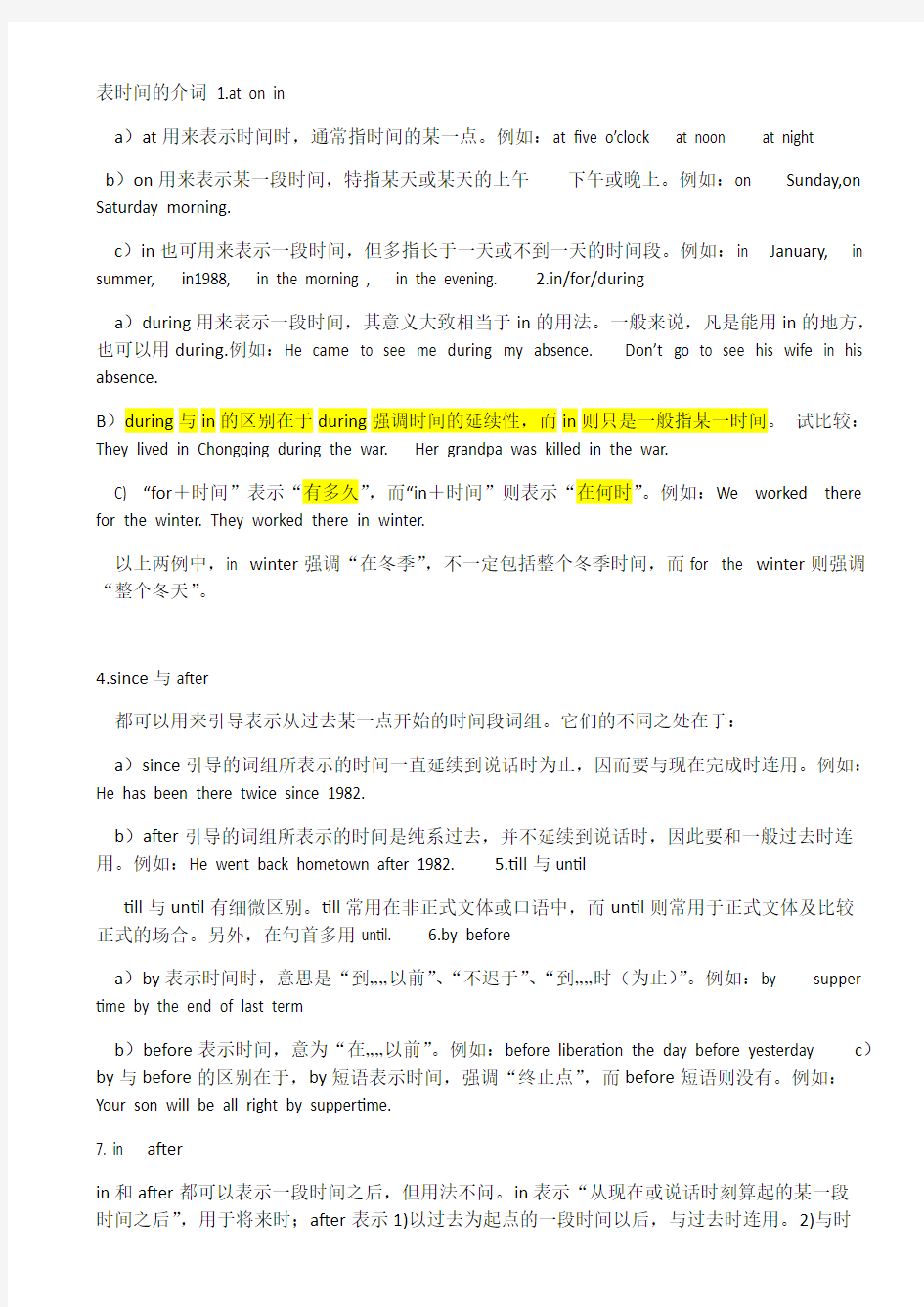
表时间的介词
- 格式:pdf
- 大小:1.11 MB
- 文档页数:5


表时间的介词 1.at on in
a)at用来表示时间时,通常指时间的某一点。例如:at five o’clock at noon at night
b)on用来表示某一段时间,特指某天或某天的上午下午或晚上。例如:on Sunday,on Saturday morning.
c)in也可用来表示一段时间,但多指长于一天或不到一天的时间段。例如:in January, in summer, in1988, in the morning , in the evening. 2.in/for/during
a)during用来表示一段时间,其意义大致相当于in的用法。一般来说,凡是能用in的地方,也可以用during.例如:He came to see me during my absence. Don’t go to see his wife in his absence.
B)during与in的区别在于during强调时间的延续性,而in则只是一般指某一时间。试比较:They lived in Chongqing during the war. Her grandpa was killed in the war.
C) “for+时间”表示“有多久”,而“in+时间”则表示“在何时”。例如:We worked there for the winter. They worked there in winter.
以上两例中,in winter强调“在冬季”,不一定包括整个冬季时间,而for the winter则强调“整个冬天”。
4.since与after
都可以用来引导表示从过去某一点开始的时间段词组。它们的不同之处在于:
a)since引导的词组所表示的时间一直延续到说话时为止,因而要与现在完成时连用。例如:He has been there twice since 1982.
b)after引导的词组所表示的时间是纯系过去,并不延续到说话时,因此要和一般过去时连用。例如:He went back hometown after 1982. 5.till与until
till与until有细微区别。till常用在非正式文体或口语中,而until则常用于正式文体及比较
正式的场合。另外,在句首多用until. 6.by before
a)by表示时间时,意思是“到……以前”、“不迟于”、“到……时(为止)”。例如:by supper time by the end of last term
b)before表示时间,意为“在……以前”。例如:before liberation the day before yesterday c)by与before的区别在于,by短语表示时间,强调“终止点”,而before短语则没有。例如:Your son will be all right by suppertime.
7. in after
in和after都可以表示一段时间之后,但用法不问。in表示“从现在或说话时刻算起的某一段
时间之后”,用于将来时;after表示1)以过去为起点的一段时间以后,与过去时连用。2)与时
间点连用,表示在将来的某一时刻之后。试比较:I will come back in two days.我过两天就回来。
I will write back in 5 days.我将在五天后给你回信。
He will come after supper. 他吃完晚饭后就过来。He left one year ago,and returned after half a year. 他一年前离开,半午后就回来了。
表地点的介词:(1)at in on to
at in on to都可以用来表示空间的位置。它们之间的区别是相当复杂的,有时不容易确定应该用哪一个。一般说来,at表示的位置是某一点;on表示的位置是一条线或一个平面上,
或表示与某地的毗邻关系小表示的位且是一个立体的地方(属于该范围)7to表示在某一地区之外的某方位(不属于该范围)。Bejing is in the north of China.北京在中国的北部。(2)below under
below表示位置低于所提及的事物,不一定是正下方;under表示“在……正下方”:(3)across,through,over
across表示“横过”.即从一边到另—边,动作是在某物的表面进行的;through表示“穿过”,即从一边进去,从另—边出来;over表示“越过”,多指在空间范围上越过。
(4)between,among
between一般是指两人或两物之间;among则指三个或三个以上的人或物之间,通常后接集
体名词或复数名词或代词。
(5)“前”与“后”
before in front of in the front of after behind 其它意思的介词:1、on/about 2、with/in/by 3、for/of
一般来说,of之前的形容词往往是用于描写入的品质的好坏,人自身的特点,这类形容词有加,kind /nice等;for之前的形容词用于描写事物的特点,如可能性,必然性,难易程度等,这类形容词有hard important easy等。
介词短语:
1. 介词与名词的搭配
the reason for the answer to the key to difference between at night at home at the end of at work at a speed of at that time at the door at present at the foot /top of at the beginning/end of by the way by the end of by bike/sea/air(交通工具)